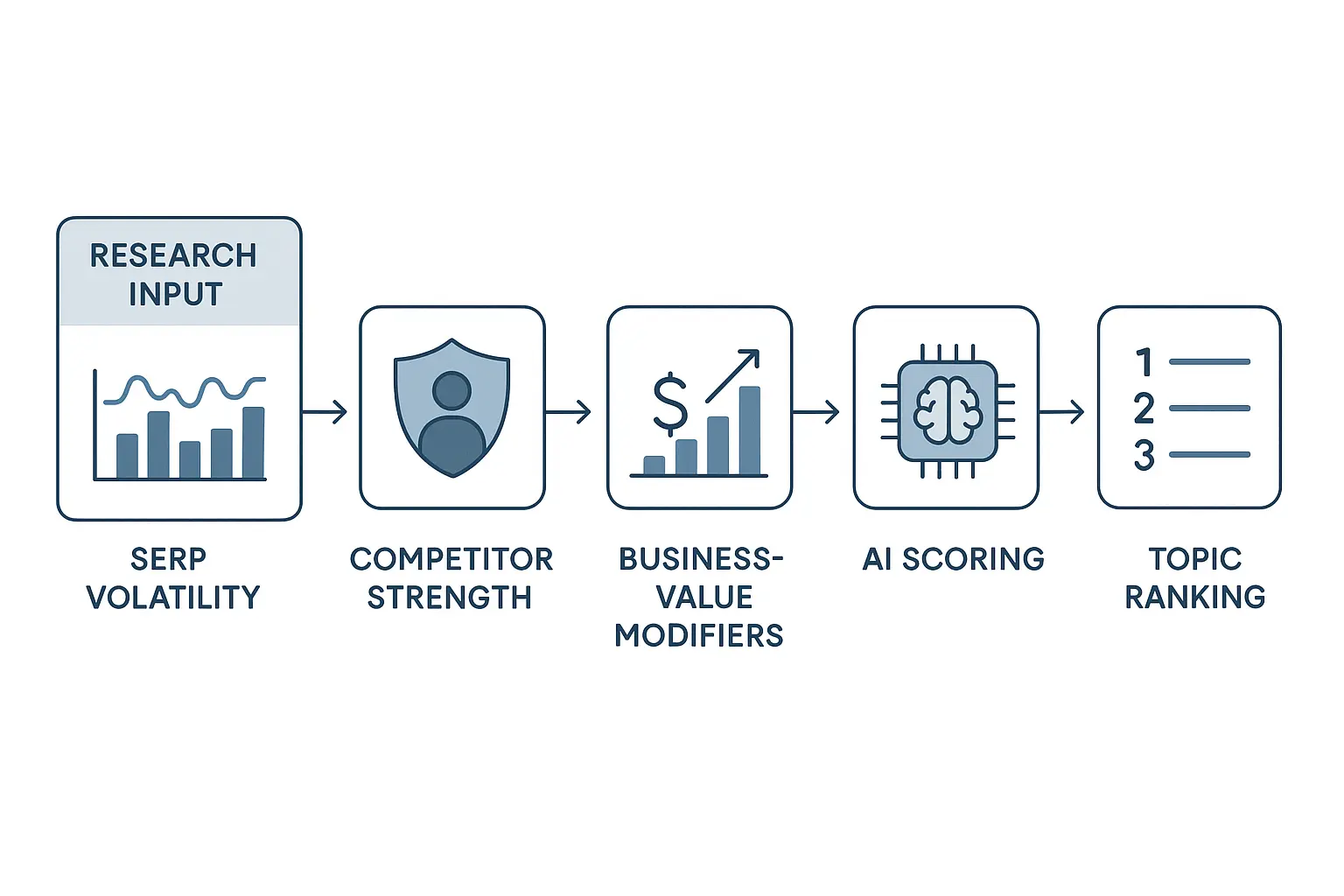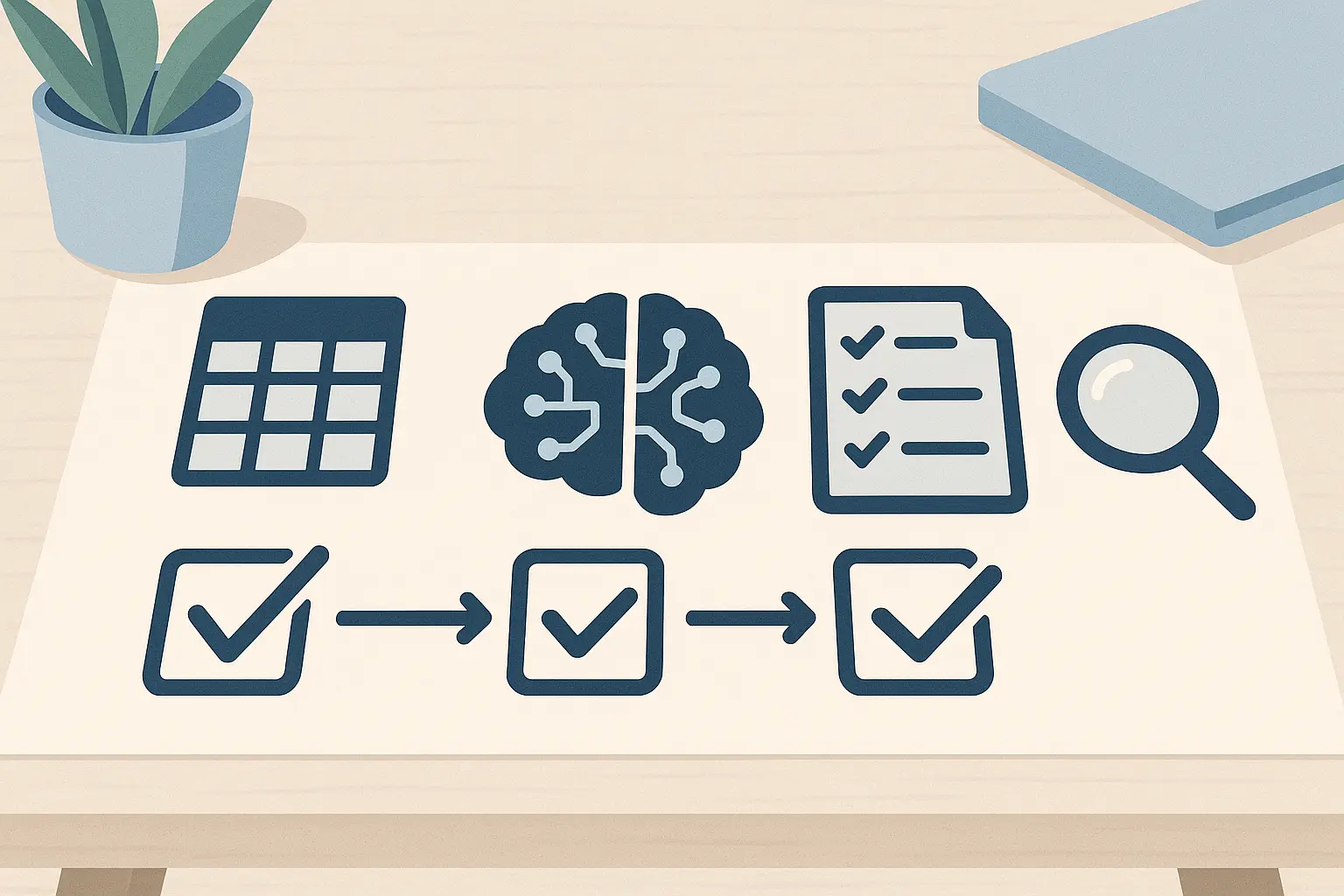You’ve been there. You present a six-month content calendar to a client, proud of your keyword research and competitive analysis. The topics are solid, the search volumes are promising.
Then the client asks the million-dollar question: “This looks great, but which articles will actually bring us customers? And how soon?”
For years, the honest answer has been some variation of, “Well, it’s complicated.” We’ve relied on a two-dimensional model of search volume and keyword difficulty—like trying to navigate a new city with a map that only shows two streets. You might find your way eventually, but you’re missing the traffic patterns, the one-way streets, and the most scenic routes.
What if you could give your client a confident, data-backed answer? What if you could forecast which topics have the highest potential for not just traffic, but actual business impact? This isn’t a fantasy. It’s the new reality powered by AI.
The Old Map: Why Volume and Difficulty Aren’t Enough
Traditional content planning is a numbers game rooted in good intentions. We identify keywords with high search volume and manageable difficulty, build a calendar, and start writing. The logic is simple: more traffic equals more opportunities.
But this model has a fundamental flaw: it treats all traffic as equal. It fails to distinguish between a curious browser and a motivated buyer. According to a Demand Gen Report, 47% of buyers view three to five pieces of content before engaging with a sales rep. This means our content needs to do more than just attract eyeballs; it needs to guide a journey.
The traditional process looks something like this:
 The New GPS: Using AI to See the Whole Picture
The New GPS: Using AI to See the Whole Picture
The future of content strategy lies in moving from a two-dimensional map to a multi-layered, real-time GPS. AI allows us to analyze variables that were previously too complex or time-consuming to track at scale, giving us a predictive edge.
A report from McKinsey found that companies using AI for lead generation see a 50% increase in leads. That’s the kind of impact that gets clients excited.
Here are the new layers AI adds to your content roadmap.
Layer 1: SERP Volatility – Is the Destination Worth the Drive?
Imagine you’re deciding between two fishing spots. One is a calm, stable lake where the fish are predictable. The other is a choppy ocean inlet where the currents—and the fish—change by the hour. Which one offers the better chance of a successful trip?
That’s SERP volatility. It measures how frequently the top-ranking pages for a given keyword change.
Low Volatility: The same few authoritative pages have dominated the top spots for months. Cracking this SERP is a long, uphill battle.
High Volatility: The top results are constantly in flux. This creates an opportunity for a high-quality piece of content to rank quickly, but holding that position can be difficult.
AI models can analyze historical SERP data to score this volatility, helping you distinguish a stable opportunity from a risky gamble. This analysis helps answer the critical question: “Is this a keyword we can realistically own long-term?”
Layer 2: True Competitor Strength – Who Are You Really Up Against?
Keyword difficulty scores are useful, but they often rely on domain-level metrics like Domain Authority (DA), which can be misleading. A high-DA site might have a weak, outdated article ranking for your target keyword, making them more vulnerable than their score suggests.
AI goes deeper by analyzing the specific pages you’ll be competing against. It looks at factors like:
- Content Quality & Depth: Does the content fully answer the user’s query?
- Topical Authority: Does the competitor have a deep library of content on this subject?
- Link Velocity: Are they actively building new, high-quality links to that specific page?
This granular analysis provides a much more accurate picture of the competitive landscape, allowing you to pick battles you can actually win.
Layer 3: Business-Value Modifiers – Connecting Content to Cash Flow
This is where AI becomes a true game-changer. It allows you to overlay your unique business goals onto the SEO data, creating a priority score that reflects real-world ROI.
This isn’t just about keywords; it’s about context. The goal is to create content that attracts the right audience at the right time. Consider this: HubSpot found that personalized calls-to-action convert 202% better than default versions. AI helps you create content that is inherently aligned with user intent.
Here’s how it works:

AI models can weigh topics based on modifiers you define, such as:
- Conversion Intent: Is the user looking to learn (“what is content marketing”) or to buy (“best content marketing agency”)? AI can analyze the language and SERP features to score that intent.
- Product/Service Alignment: Which of your services is most profitable or has the highest priority? Topics aligned with high-priority services receive a higher value score.
- Audience Fit: Does the keyword attract your Ideal Customer Profile (ICP)? A topic for a small business owner has a different value than one for an enterprise CMO.
By combining these layers, AI generates a holistic priority score. You’re no longer just looking at a list of keywords; you’re looking at a strategic roadmap where every piece of content has a clear, justifiable business case.

From Guesswork to a Growth Engine
Imagine your next client meeting. Instead of presenting a simple calendar, you share a prioritized roadmap.
You can say, “We’re starting with these three topics because our AI model gives them the highest ROI score. They target a stable SERP, face manageable competition, and align directly with your highest-priority service. We forecast they will drive not just traffic, but qualified leads within the next quarter.”
That’s the difference between selling content and selling a growth strategy. You move from being a service provider to an indispensable partner.
This shift is already happening—the AI in marketing industry is projected to hit $107.5 billion by 2028, and agencies that adapt will be the ones that thrive. By integrating AI, you’re not just optimizing content; you’re building a predictable, scalable engine for client growth.
Frequently Asked Questions (FAQ)
Isn’t keyword volume still the most important metric?
Volume is an important piece of the puzzle, but it’s not the whole picture. A keyword with 10,000 monthly searches that doesn’t lead to conversions is far less valuable than one with 100 searches that consistently generates high-quality leads. AI helps you find the sweet spot between traffic potential and business value.
Can AI really predict which content will convert?
AI doesn’t have a crystal ball, but it can make highly educated predictions based on data. By analyzing the language, intent signals, and SERP features associated with your target keywords, it can assign a “conversion potential” score. This score indicates the likelihood that a user searching for that term is in a buying mindset, allowing you to prioritize topics that attract users closer to the bottom of the funnel.
How is an AI-driven plan different from a standard content strategy?
A standard strategy often prioritizes traffic potential, while an AI-driven strategy prioritizes business outcomes. It uses a multi-factor scoring system to rank topics based on a combination of traffic potential, conversion likelihood, competitive reality, and alignment with your specific business goals. It’s a shift from being reactive to SEO trends to being proactive about driving revenue.
Do I need to be a data scientist to implement this?
Not at all. The power of modern AI platforms and partners is that they do the heavy lifting for you, translating complex data into clear, actionable insights and prioritized to-do lists. Your job is to provide the strategic business context—the AI handles the number-crunching.
Your Next Step: From Theory to Action
Understanding how AI can forecast content ROI is the first step. The next is to see how it can transform your agency’s service delivery and client results.
With the right approach, you can build a powerful, scalable, and profitable content machine under your own brand. By shifting your focus from pure volume to predictable value, you not only improve client outcomes but also solidify your position as a forward-thinking leader.
When you’re ready to put this theory into action, the right partnership can help your agency scale with powerful white-label SEO services.

